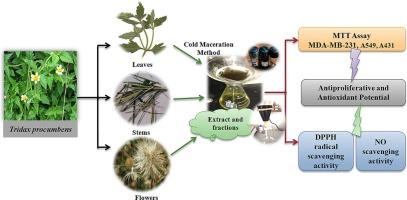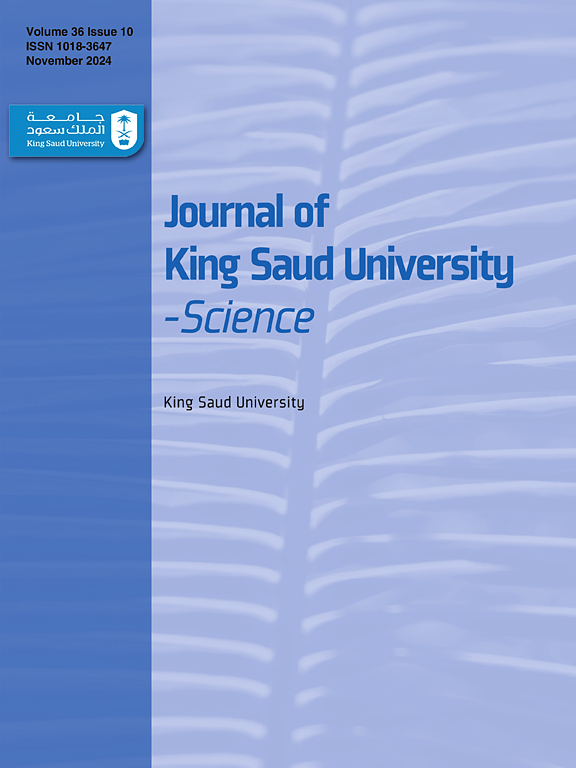踯躅草提取物对多种人类癌细胞株的抗增殖和抗氧化潜力:从杂草中提取药物的启示
IF 3.7
3区 综合性期刊
Q1 MULTIDISCIPLINARY SCIENCES
引用次数: 0
摘要
本研究旨在评估砗磲的抗癌和抗氧化潜力,并采用反相高效液相色谱法鉴定其主要酚类化合物。研究采用液-液分配法将普鲁卡因的粗提取物分离成不同的馏分。在人类癌症细胞系(PC-3、COLO-205、A549、A431、MDA-MB-231、MDA-MB-468 和 K562)以及对照细胞系(HEK-293)上测试了 T. procumbens 的粗提取物和馏分。此外,还评估了提取物和馏分的抗氧化活性。根据从 23.41 微克/毫升到 90.76 微克/毫升不等的 IC50 值,大多数提取物似乎都能抑制人类癌细胞系的发展。不过,茎(7)的氯仿馏分对 A431 和 MDA-MB-231 具有很强的活性,IC50 值分别为 23.41 克/毫升和 29.45 微克/毫升。抗氧化结果显示,提取物及其馏分清除自由基的 IC50 值介于 14.70 和 93.80 µg/mL 之间。不过,7 号提取物的功效更高,在 DPPH 试验中的 IC50 值为 14.70 µg/mL ,在一氧化氮试验中的 IC50 值为 29.90 µg/mL。高效液相色谱分析显示,T. procumbens 的花朵部分含有大量阿魏酸(0.55-2.65 毫克/克)和山柰酚(1.1-4.95 毫克/克)。在 DPPH 和 NO 检测中观察到的强抗氧化活性有助于衡量提取物在清除 NO 自由基、中和其他活性氧(ROS)方面的有效性。这项研究凸显了植物化合物在癌症治疗中的潜力。本文章由计算机程序翻译,如有差异,请以英文原文为准。

Antiproliferative and antioxidant potential of Tridax procumbens extracts against various human cancer cell lines: An insight for medicines from weeds
This study aimed to evaluate the anticancer and antioxidant potential of Tridax potential and to identify its main phenolic compounds using reverse-phase HPLC. The crude extract of T. procumbens was separated into different fractions using the liquid–liquid partition method. T. procumbens crude extracts and fractions were tested on human cancer cell lines (PC-3, COLO-205, A549, A431, MDA-MB-231, MDA-MB-468, and K562) as well as a control cell line (HEK-293). The antioxidant activities of the extracts and fractions were also assessed. The majority of the extracts appeared to inhibit the progression of human cancer cell lines based on IC50 values that varied from 23.41 to 90.76 µg/mL. However, the chloroform fraction of the stem (7) displays strong activity against A431 and MDA-MB-231, with IC50 values of 23.41 g/mL and 29.45 µg/mL, respectively. The antioxidant result shows that extracts and their fractions scavenge free radicals with an IC50 value between 14.70 and 93.80 µg/mL. However, 7 showed more efficacies with an IC50 of 14.70 µg/mL in the DPPH assay and 29.90 µg/mL in the nitric oxide assay. HPLC analysis revealed that the flower part of T. procumbens contains high levels pf ferulic acid (0.55 to 2.65 mg/g) and kaempferol (1.1 to 4.95 mg/g). A strong antioxidant activity observed in DPPH and NO assay which helps to measure the extract’s effectiveness in scavenging NO free radical, neutralizing other reactive oxygen species (ROS), often correlate with significant antiproliferative effects in various cancer cell lines. This study highlights the potential of plant-based compounds in cancer treatment.
求助全文
通过发布文献求助,成功后即可免费获取论文全文。
去求助
来源期刊

Journal of King Saud University - Science
Multidisciplinary-Multidisciplinary
CiteScore
7.20
自引率
2.60%
发文量
642
审稿时长
49 days
期刊介绍:
Journal of King Saud University – Science is an official refereed publication of King Saud University and the publishing services is provided by Elsevier. It publishes peer-reviewed research articles in the fields of physics, astronomy, mathematics, statistics, chemistry, biochemistry, earth sciences, life and environmental sciences on the basis of scientific originality and interdisciplinary interest. It is devoted primarily to research papers but short communications, reviews and book reviews are also included. The editorial board and associated editors, composed of prominent scientists from around the world, are representative of the disciplines covered by the journal.
 求助内容:
求助内容: 应助结果提醒方式:
应助结果提醒方式:


